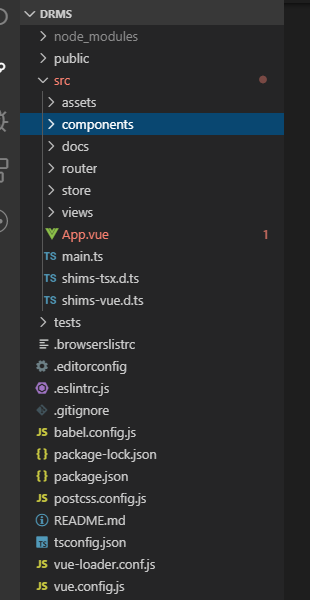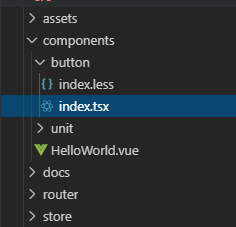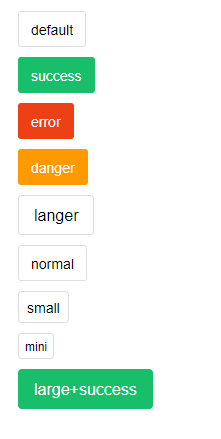一年又要到年底了,vue3.0都已经出来了,我们也不能一直还停留在过去的js中,是时候学习并且在项目中使用一下Ts了。
如果说jsx是基于js的话,那么tsx就是基于typescript的
废话也不多说,让我们开始写一个Tsx形式的button组件,
ts真的不仅仅只有我们常常熟知的数据类型,还包括接口,类,枚举,泛型,等等等,这些都是特别重要的
项目是基于vue-cli 3.0 下开发的,可以自己配置Ts,不会的话那你真的太难了

我们再compenonts中新建一个button文件夹,再建一个unit文件夹,button放button组件的代码,unit,放一些公共使用模块
我们再button文件夹下创建 ,index .tsx放的button源码,index.less放的是样式,css也是不可缺少的

分析一下button需要的一些东西
第一个当然是props,还有一个是点击事件,所以我们第一步就定义一下这两个类型
type ButtonProps = { tag: string, size: ButtonSize, type: ButtonType, text: String } type ButtonEvents = { onClick?(event: Event) :void } type ButtonSize = 'large' | 'normal' | 'small' | 'mini' type ButtonType = 'default' | 'primary' | 'info' | 'warning' | 'danger'
因为button是很简单的组件,内部也没有一些特别的状态需要改变,所以我们用函数式组件的方式去写(之后的render会用到这个方法)
function Button (h: CreateElement, props: ButtonProps, slots: DefaultSlots, ctx: RenderContext<ButtonProps>) { const { tag, size, type } = props let text console.log(slots) text = slots.default ? slots.default() : props.text function onClick (event: Event) { emit(ctx, 'click', event) } let classes = [size,type] return ( <tag onClick = {onClick} class = {classes} > {text} </tag> ) }
h 是一个预留参数,这里并没有用到 ,CreateElement 这个是vue从2.5之后提供的一个类型,也是为了方便在vue项目上使用ts
props 就是button组件的传入的属性,slots插槽,ctx,代表的是当前的组件,可以理解为当前rendercontext执行环境this
DefaultSlots是我们自定义的一个插槽类型
export type ScopedSlot<Props = any> = (props?: Props) => VNode[] | VNode | undefined; export type ScopedSlots = { [key: string]: ScopedSlot | undefined; }
插槽的内容我们都是需要从ctx中读取的,默认插槽的key就是defalut,具名插槽就是具体的name
button放发内部还有一个具体的点击事件,还有一个emit方法,从名字我们也可以看的出,他是粗发自定义事件的,我们这里当然不能使用this.emit去促发,
所以我们需要单独这个emit方法,我们知道组件内所以的自定义事件都是保存在listeners里的,我们从ctx中拿取到所以的listeners
function emit (context: RenderContext, eventName: string, ...args: any[]) { const listeners = context.listeners[eventName] if (listeners) { if (Array.isArray(listeners)) { listeners.forEach(listener => { listener(...args) }) } else { listeners(...args) } }
这样我们组件内部的事件触发就完成了
我们的button肯定是有一些默认的属性,所以,我们给button加上默认的属性
Button.props = { text: String, tag: { type: String, default: 'button' }, type: { type: String, default: 'default' }, size: { type: String, default: 'normal' } }
我们定义一个通用的functioncomponent 类型
type FunctionComponent<Props=DefaultProps, PropsDefs = PropsDefinition<Props>> = { (h: CreateElement, Props:Props, slots: ScopedSlots, context: RenderContext<Props>): VNode |undefined, props?: PropsDefs }
PropsDefinition<T> 这个是vue内部提供的,对 props的约束定义
不管怎么样我们最终返回的肯定是一个对象,我们把这个类型也定义一下
ComponentOptions<Vue> 这个也是vue内部提供的
interface DrmsComponentOptions extends ComponentOptions<Vue> { functional?: boolean; install?: (Vue: VueConstructor) => void; }
最终生成一个组件对象
function transformFunctionComponent (fn:FunctionComponent): DrmsComponentOptions { return { functional: true, // 函数时组件,这个属性一定要是ture,要不render方法,第二个context永远为underfine props: fn.props, model: fn.model, render: (h, context): any => fn(h, context.props, unifySlots(context), context) } }
unifySlots 是读取插槽的内容
// 处理插槽的内容 export function unifySlots (context: RenderContext) { // use data.scopedSlots in lower Vue version const scopedSlots = context.scopedSlots || context.data.scopedSlots || {} const slots = context.slots() Object.keys(slots).forEach(key => { if (!scopedSlots[key]) { scopedSlots[key] = () => slots[key] } }) return scopedSlots }
当然身为一个组件,我们肯定是要提供全局注入接口,并且能够按需导入
所以我们给组件加上名称和install方法,install 是 vue.use() 方法使用的,这样我们能全部注册组件
export function CreateComponent (name:string) { return function <Props = DefaultProps, Events = {}, Slots = {}> ( sfc:DrmsComponentOptions | FunctionComponent) { if (typeof sfc === 'function') { sfc = transformFunctionComponent(sfc) } sfc.functional = true sfc.name = 'drms-' + name sfc.install = install return sfc } }
index.tsx 中的最后一步,导出这个组件
export default CreateComponent('button')<ButtonProps, ButtonEvents>(Button)
还少一个install的具体实现方法,加上install方法,就能全局的按需导入了
function install (this:ComponentOptions<Vue>, Vue:VueConstructor) { const { name } = this Vue.component(name as string, this) }
最终实现的效果图,事件的话也是完全ok的,这个我也是测过的

代码参考的是vant的源码:https://github.com/youzan/vant
该代码已经传到git: https://github.com/czklove/DrpsUI dev分支应该是代码全的,master可能有些并没有合并